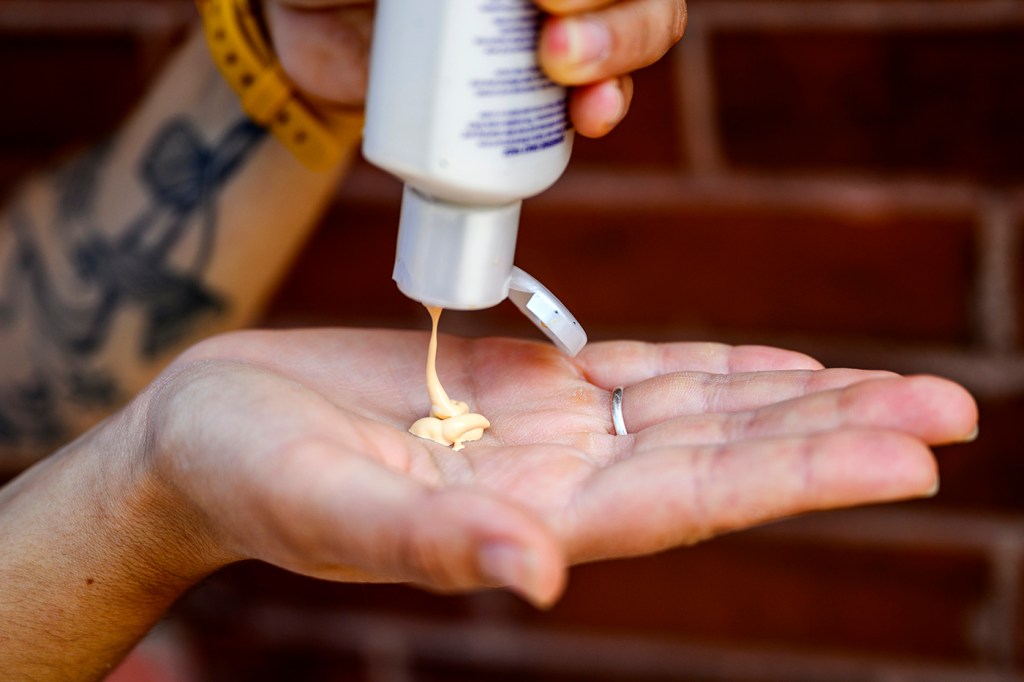Chemicals found in sunscreen and makeup can lead to hypertension during pregnancy, new study finds
“We’re exposed to many different chemicals at one time, so we really want to look at the mixture effect like what’s the cumulative effect of all of those exposures at once,” says Northeastern professor Julia Varshavsky.

Chemicals found in certain personal care products — including sunscreen and makeup — may cause hypertension during pregnancy and affect the long-term health of both the pregnant parent and the fetus, according to a study led by a Northeastern professor.
The study found that phenols and parabens, chemicals that are widely used as UV filters in sunscreen and to prevent bacteria and mold growth in cosmetics, may increase the risk of high blood pressure during pregnancy. Researchers looked at the associations between individual phenols and parabens, as well as what happens when they’re combined, targeting products pregnant people are likely to use often.
“A lot of studies only look at one chemical exposure at a time,” said Julia Varshavsky, assistant professor of environmental health at Northeastern University and lead scientist on the study. “But we’re actually exposed to many different chemicals at one time, so we really want to look at the mixture effect like what’s the cumulative effect of all of those exposures at once.”
Featured Posts
Previous studies in this field looked more at the impact these exposures had on the fetus and childhood development, Varshavsky said. But this study focused on the pregnant person and the effects exposures can have on them both during the pregnancy and in the longer term.
“There’s been a more recent shift to actually think about how those exposures actually impact the pregnant individuals’ health after pregnancy,” Varshavsky said. “We’re learning more and more that the mom’s cardiovascular health during pregnancy actually has a lot of lifelong health consequences for that person down the road.”
If a person develops hypertension during pregnancy, it can put them at risk for other pregnancy complications, including early labor, preeclampsia and diabetes.
“People who develop hypertension for the first time during pregnancy then are at increased risk of developing hypertension after pregnancy,” Varshavsky added. “Hypertension is dangerous in terms of cardiovascular health and increasing risk of heart disease and complications related to the heart. It also increases your risk of obesity and diabetes later.”
The study specifically looked at pregnant women in Puerto Rico living in a region with a high amount of environmental toxins. Varshavsky said Puerto Rico has one of the highest proportions of Superfund sites — locations with hazardous chemical exposures — in the United States. The participants are part of the PROTECT cohort, part of the PROTECT Center which studies exposure to environmental contamination in Puerto Rico and how it contributes to adverse pregnancy outcomes. The center has been following these women since 2010.
“They’ve had a lot of increased exposure to environmental toxins through other sites over time, and they’re also dealing with poverty,” she said. “They’re also right now dealing with a lot of climate change and disaster-related events that are impacting water quality, that are impacting housing. It’s important to think about chemical exposures, but there are other exposures during pregnancy that are also impacting the health of these women.”
Pregnant people are more susceptible to certain exposures because of the changes their body is undergoing. These shifts open up the molecular signaling pathways, allowing for more of a potential impact from different chemicals.
The body is similarly susceptible during other big changes like puberty, Varshavsky said.
“Anytime there’s a period of extreme biological change, there’s a lot of sensitive hormone signaling going on, and these chemicals can impact that signaling,” Varshavsky added. “They can either block hormones from binding to their receptors that they need to bind to in order for the messaging to go through or they can act like the hormones and start binding to more of those receptors than they should be and that creates a cascade of molecular signaling events that can also lead to things like cancer, in tissues that are sensitive to hormone signaling.”
Varshavsky said it’s unclear what it is about these chemicals that can increase the risk of hypertension, but she hopes the study will increase awareness of the impact exposure can have and get people to push for safer alternatives.
“The way the U.S. chemicals policy works right now is that companies are allowed to put chemicals into commerce without them being tested for safety ahead of time,” she said. “That’s just the way the U.S. chemicals policy has always worked. So we’re constantly trying to play catch-up and there’s no incentive for the industry to think about how they make our sunscreens effective without being filled with harmful chemicals.
“We need to be pushing for that kind of policy change that reduces the ability of the industry to put toxic chemicals in products before we even know what they are. There’s also an important call for needing safer alternatives. We need sunscreen to protect us from skin cancer, but we need sunscreen that doesn’t contain harmful chemicals. Some of those alternatives exist, but there aren’t enough of them.”











